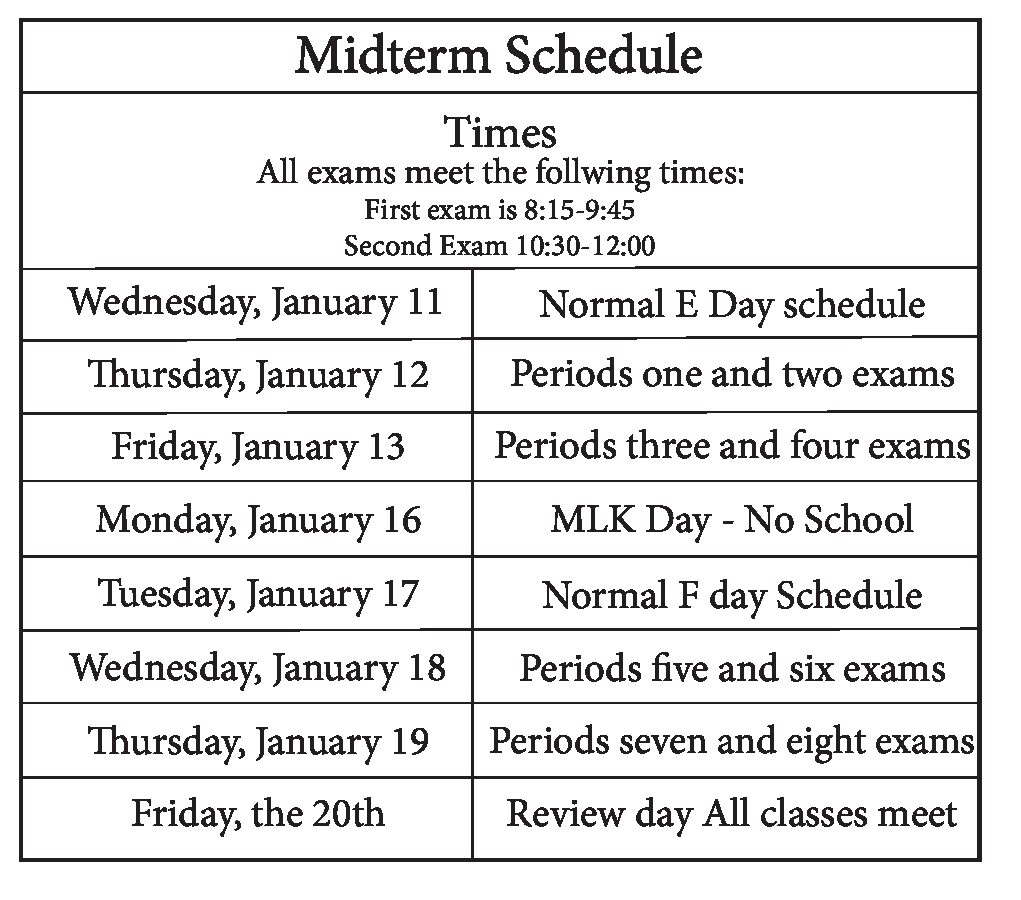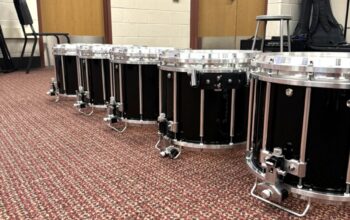Bridget Flatow, Reporter
@BFlatowCourant
For the first time in three years, midterms will be administered. They will begin on January 12 and testing will continue until January 19, with an extra day on January 20th to review and make up any missed exams. Along with providing support to students to help them prepare for the exams, administrators have created a schedule that will directly benefit students.
The test schedule will go as follows: The first review day will begin January 11 and will be a regular E day, students will meet and prepare for their periods 1-4 exams. On January 12 and 13, students will have their periods 1-4 exams. After the Martin Luther King Jr. long weekend on January 17, students will have a regular F day and meet with periods 5-8. January 18 and 19 will be held for period 5-8 exams. On Friday, January 20, every class period will meet and will be designated as a review and make-up day.
Despite the “normalcy” of midterms this year, there will be a couple of changes. “What is different from last year is we will be breaking the testing into review days, so students won’t have four days of exams in a row,” Assistant Principal Ari Rothman said “This way instead of having all 8 periods meet for half an hour for review and then not taking the test until theoretically a week after that, you will meet for review with classes 1-4, take the tests for those classes and then periods 5-8 meet for review and take the test.”
Administrators have made a change to this year’s midterms weighting. Before COVID, teachers could make their midterm exams a maximum of 20 percent of a student’s semester grade. “Percentage is decided by the teachers, but all the teachers of the same course have to do it the same. The only thing we’ve established as a school is it can’t be more than 10 percent,” Mr. Rothman said. “An hour and a half of a semester will not have so much more weight than the work that you do over the course of a quarter.”
Midterms will look different for each department. The Math department has left it up to the teachers to decide what format the midterm will be. “Some courses may be taking a traditional exam, some may be doing a shared experience, kind of like a project, and some may be doing a hybrid mix of one or the other,” math teacher William Doyle said.
Math midterms will be standardized depending on the course a student is taking. “Everyone that’s in the same course will have the same experience,” said Mr. Doyle.
The math department will be distributing study guides before the holiday break, so students can take advantage of that time if they choose to do so. Mr. Doyle said, “[The math department] suggests doing 15 minutes here, 15 minutes there.”
Additionally, the science department is making midterms similar to the tests students have been taking all year. “ If you’ve been working on a lot of multiple choice questions and short answer questions and diagrams all year you can assume that’s what your midterm format will look like as well,” Science department chair Michael LeDuc said.
Due to changes in learning during the pandemic, the science department has made shifts to increase emphasis on analysis and scientific skills that will be reflected in the midterms. “I think we know that students largely have access to concepts that they used to memorize in the past. Now it’s more about how well students can analyze and apply.” Mr. Leduc said.
The English department will be conducting midterms differently this year as well. One of the key changes being the administration of diagnostic tests during the exam periods. “The 9th grade team is going to administer one of our reading benchmarks,” English Department Head, Evan Remley said. “We’re not going to count it as a grade because it’s the same for the benchmark to work and has to be the same assessment.”
Mr. Remley expects most teachers to do some sort of essay and build off of what they have been working on with their students for grades 10-12. “The teachers that teach the same section are all working together to come up with a common experience with what midterms might look like.” Mr. Remley said.
However, midterms will look different for students who are in AP English classes. “For the AP classes, students signed up to take a class that’s a big summative test, so it makes sense at this point in time in the year to do a practice version of that,” Mr. Remley said.
“Midterms reflect what we’ve been doing in class all along, the external pressures and misconceptions of midterms are more of a battle that students face.”
Michael Forcucci
The Social Studies Department plans on shifting the format of midterm exams this year. “Increasingly [the Social Studies Department]is trying to make our midterms less of just memorizing a ton of information and then spit it back out and more consider what students learned over the first semester and apply it to new primary sources,” Social Studies Department Head Michael Forcucci said.
This year’s history midterms will take the format of evidence-based reading and writing, such as DBQs. “This change attempts to make midterms more of a learning experience than just a stock assessment.” Mr. Forcucci said.
However, AP Students will continue to have midterm exams that reflect the AP exam. “The exam is what students are preparing for and a lot of the students are there to do well on that exam,” Mr. Forcucci said.
Preparing students for the midterm exam will be unique for each teacher and class; however, the Social Studies department has been talking about adding some preparation in advance to help students such as giving them the prompt for the DBQ in advance. “We will be giving students one piece of the puzzle in order to come in prepared but still asking that they apply some new thinking into the task.” Mr. Forcucci said.
Midterms can be a stressful time for all students, but it’s important to stay calm and remember that midterms are made to benefit students. “Oftentimes students misinterpret the value of midterms,” Mr. Forcucci said. “10 percent is pretty minuscule at the end of the day. Midterms are an opportunity for students to show what they’ve learned and what they can do.”




